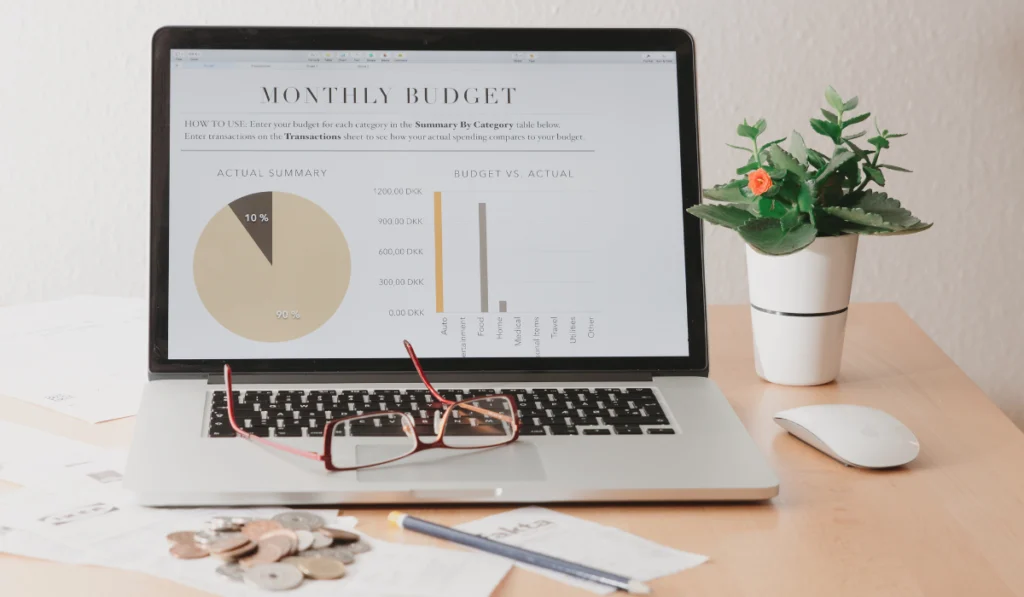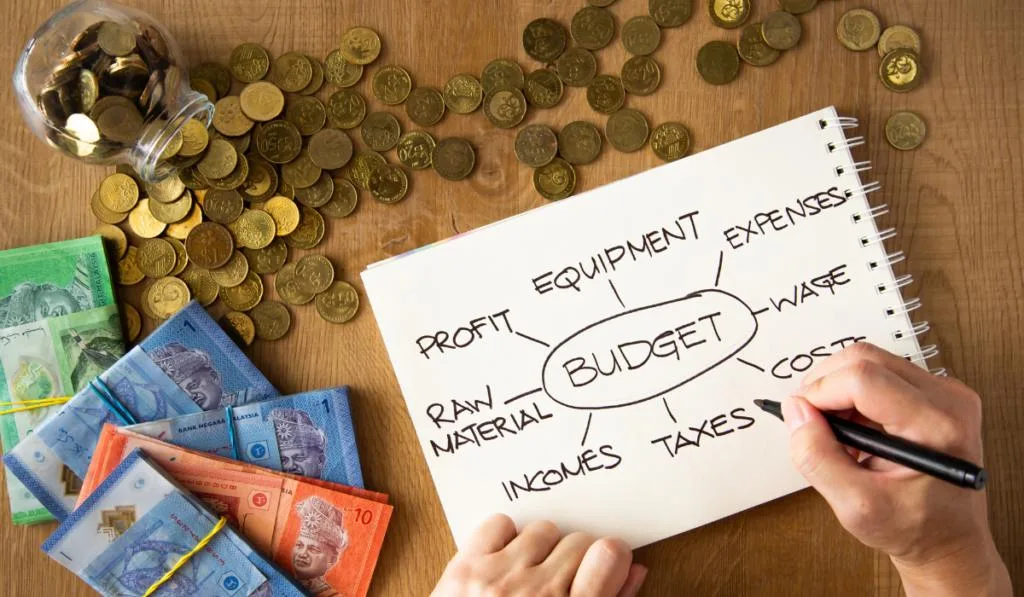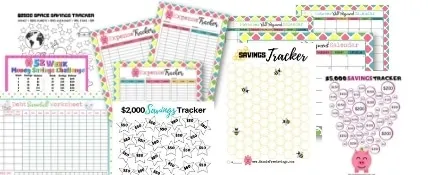*This post may have affiliate links, which means I may receive commissions if you choose to purchase through links I provide (at no extra cost to you). As an Amazon Associate I earn from qualifying purchases. Please read my disclaimer for additional details. Thank you for supporting the work I put into this site!
Creating a budget doesn’t have to be time-consuming or difficult. In reality, the simplest budgeting strategies are typically the most effective.
You can securely prevent overspending and steadily grow your savings with a clear monthly budget overview, even if you don’t keep detailed records of each and every purchase.

How do you budget when you get paid monthly? The general rule of thumb is to allocate 50% of your after-tax income toward necessities, 30% toward wants, and 20% toward savings or debt repayment each month.
Keeping your spending in check across these primary categories on a regular basis will allow you to put your money to better use.
Keep reading to learn more about the most effective approach to monthly budgeting.
Plan Ahead
Preparation is the key to ensuring a smooth monthly cash flow. When you plan ahead for the month, you’re less likely to be caught off guard by unexpected events.
When you get paid every month, it’s easier to save and invest so that you can reach your financial goals sooner.
All of your regular payments can be deducted automatically from your monthly paycheck. That way, you won’t have to put money away from each paycheck to pay for things like rent, mortgage, school loans, and other recurring expenses.
This simplifies the process of settling financial obligations.
However, when you only get paid once a month, spending all your extra cash before your next paycheck arrives is all too easy, making it harder to avoid a financial shortfall. That’s why you need to have a plan.
How to Get Started?
Step One: Examine Your Paycheck
Check your paycheck for a starting point. Deduct the amount withheld for taxes from your total payment.
Don’t forget about other potential deductions, such as health insurance or retirement savings. You need to include those in your overall spending plan.
Step Two: Divide Your Paycheck
You should prioritize your needs (50%), your wants (30%), and your savings (20%) according to the 50-30-20 monthly budget plan.
Needs: 50%
Spend around half of your income on necessities. Utility bills are one example of a fixed cost that cannot be avoided. If you find yourself saying, “I can’t live without it,” you’ve found a need.
Credit card and loan payments also fall into this group.
The bare minimum of what your needs should include are:
- Groceries
- Housing
- Basic utilities
- Transportation (fuel, public transport tickets, car leasing, or car loan payment)
- Insurance
- Child care
- Minimum on all loan payments
Over and above the bare minimum, any additional funds should be put toward paying off debt or saving.
Your budget’s “wants” category may need to be temporarily accessed if your spending on necessities exceeds the 50% mark. It’s not the end of the world, but you must change your spending habits.
If your essentials fall over the 50% limit, evaluating these fixed expenses on a regular basis is an excellent strategy.
You might discover a better mobile phone plan, a chance to refinance your home loan, or a way to get cheaper life or car insurance. That gives you more options elsewhere.
Wants: 30%
Sometimes it’s hard to tell what you actually need from what you just want. In a nutshell, your needs are the backbone of your day-to-day existence. Restaurant meals, presents, and vacations are examples of typical wants.
Subscribing to a streaming service only to watch your favorite show is a great illustration of this concept, as opposed to subscribing because you need the service to survive.
Wants are luxuries for which you willingly pay money.
If you’re determined to reduce your debt as quickly as possible, you can opt to put off satisfying your desires until you’ve built up some emergency funds or reduced your monthly payments.
However, your spending plan shouldn’t be so stringent that you never treat yourself to something pleasurable.
Savings: 20%
Put aside 20% of your take-home money for emergencies, long-term goals, and debt reduction. The money you save can go toward a down payment on a property, an emergency fund, or both.
Reducing debt by more than the required minimum payment also fits here.

6 Tips for a Successful 50-30-20 Monthly Budget Strategy
1. Track Your Spending
Spending records are a vital aspect of any sound financial strategy. If you are diligent about recording all of your expenses, you can estimate the average amount that your monthly bills for groceries, utilities, and other purchases will be.
On the other hand, by doing so, you will quickly become aware of areas in which you can reduce your spending and where you are losing money.
If you don’t keep track of your spending, your bank statement might still provide you with a rough estimate of what you can expect to pay in the future. This is because following the path of your money is extremely easy with electronic transfers.
2. Get Your Bills Paid on Payday
If you get paid once per month, you can schedule your bills to be paid at the same time.
Making a lump-sum payment for all your fixed expenses is more convenient and time-efficient.
In general, paying your expenses as soon as you get paid helps ensure they are paid on schedule.
It also prevents you from using bill money for something else and falling behind on payments.
The vast majority of service providers now permit direct debit as a method of payment. However, this may be trickier with bills that vary in price, such as those for utilities.
If you decide to set up a direct debit for these payments, make sure to account for price changes.
On the other hand, many utility providers let you choose between variable rates based on your actual consumption and a fixed rate based on your projections.
This would mean paying more in months with lower usage and less in months with higher usage, but the total amount you paid would be stable and predictable.
3. Save as Much as You Can!
Bills must be paid, but don’t forget to take care of number one: yourself. It’s common to have good intentions about saving money, only to realize that by the end of the month, you don’t have as much extra cash as you’d hoped to sock away.
If this is you, then you should treat your savings with the same urgency as your other financial obligations and put money towards them as soon as you get paid.
This will not only help you save more money, but it will also provide you with a safety net in the event of an emergency.
Many banks now allow you to set up separate savings accounts for each of your goals, which can help you stay on target.
In this approach, you can easily separate your savings for specific purposes (such as an unexpected expense fund or vacation) and monitor their development.
4. No Credit Cards, No Checks, Spend Solely in Cash
Switch the remaining categories in your budget to the envelope system or a cash-only basis.
This method means that you will not use your debit card at all but will only use the cash for each category to make your purchases.
At the start of the month, take the money out of your bank account. Arrange the cash in envelopes labeled for their respective uses, with the accurate sums in each.
If you divide your budget into sections for things like food, entertainment, and travel, you won’t go broke eating out in the first week and will know when to cut back on that particular area of expenses.
5. Make a Weekly Budget and Stick to It
When you get paid every month, it’s natural to think that the substantial sum will easily tide you over until the following payment. However, this isn’t always the case.
Therefore, imposing some spending restrictions on yourself may be beneficial, such as dividing your monthly paycheck into weekly chunks.
Limit yourself to a certain amount each week, and don’t exceed it when you go out. The use of envelopes is also helpful in this approach.
This tangible and immediately visible method is ideal if you want to avoid unnecessary purchases and keep your monthly budget under control.
6. Have Everyone Chip in to Create a Family Budget
You can better manage your finances by adopting a cash-only budget and establishing weekly restrictions, but it’s important to involve everyone in the household in this change.
You probably know that it’s so much easier to say “no” to ourselves than to a youngster who looks us in the eye and begs for a new toy.
If you want to keep your spending under control, you may have to learn to say no.
Make family budgeting a group effort. It’s smart to provide each family member with their own cash envelope to use for personal spending.
That way, you won’t waste time explaining money matters all the time and to one another, and everyone may handle their own funds independently.
What if You Fall Short?
Life is full of surprises, and even with careful budgeting, you may find that one month of your paycheck isn’t enough to cover your needs. That’s why it’s important to consider your fallbacks before things turn dire.

1. Create an Emergency Fund
When you only get paid once a month, the month can seem quite long, especially if you have to pay for car repairs or other emergencies.
A savings account set aside for unexpected costs is one way to avoid going into debt. Having an emergency fund is crucial regardless of how often you are paid, especially if you only get paid once a month.
An unexpected expense at the beginning of the month can leave you scrambling to make ends meet for the rest of the month.
It is recommended by experts that you have three to six months’ worth of costs saved up in case of an unforeseen circumstance.
2. Credit Card
While paying for unforeseen expenses with cash on hand is preferable, a credit card might be a useful alternative. But make sure you can afford to pay the charge in full monthly.
If Necessary, Reevaluate Your Budget
After all the advice we’ve given, this is the one I really want you to keep in mind. As the saying goes, “Practice makes perfect,” so it’s possible that you won’t succeed brilliantly at budgeting right away. Or the second or third time.
But don’t give up.
New financial strategies need to be implemented gradually.
Don’t be hesitant to reevaluate your budget every so often, either.
You should take your time to choose the best budgeting approach for your needs because there is no one-size-fits-all solution. Stay positive and keep trying.
Online Budgeting Tools
The right budgeting software might help you feel more in control of your money. Thankfully, there are many accessible and free budgeting resources available on the web.
You can monitor where your money is going with the help of a basic budget app, which will typically sync with your bank accounts, track spending, and organize costs.
There are many programs that offer a plethora of features to meet your individual budgeting requirements.
13 Online Budgeting Tools
- Mint
- BudgetPulse
- YNAB
- Buxfer
- MoneyStrands
- Goodbudget
- PocketGuard
- Fudget
- SavvyMoney
- My Spending Plan
- BudgetSimple
- EveryDollar
- Honeydue
Professional Evaluation of Your Budget
If you’ve tried to create a family budget but found it challenging to stick to or felt that your spending wasn’t optimally planned, don’t be afraid to seek expert assistance in reviewing your budget or helping you plan your debt management strategies.
The Key Challenges of Home Budgeting Are:
- Debt that is hard to get rid of and growing like a snowball, and you don’t see any way to pay for the costs that keep going up.
- Something always seems to get in the way of your plans and makes you spend more than you had planned.
- The rules are too strict, or the method is too hard to follow.
- There seems to be no end until you start spending some of your money on something you enjoy.
- Working full-time and juggling child care or other responsibilities makes it next to impossible to create or maintain the family budget.
- You feel guilty about spending money on yourself because you believe it could be “put to better use” somewhere else.
Knowing we could improve our financial situation and experiencing a sense of being behind is upsetting. It’s time to let go of that feeling and admit that you need support.
You don’t have to face these problems on your own. Sometimes it’s a good idea to meet with an expert and ask for help.
Professionals who are skilled in debt relief and budget planning will craft a spending plan that is just right for you and your situation.
This way, you can skip the time-consuming process of creating a budget on your own and jump right into implementing the most efficient strategy.

Final Thoughts
In order to save money, get out of debt, or stop living paycheck to paycheck, a well-thought-out budget is essential.
A budget can be considered the supporting structure of your financial life; it details how and where your income will be allocated so that you can meet your ongoing living costs and long-term financial objectives.
And remember, having a budget doesn’t have to be limiting. Actually, it helps you rein in your spending so you can get the things you desire without breaking the bank.
Resources
- https://www.nerdwallet.com/article/finance/how-to-budget
- https://www.nerdwallet.com/article/finance/budget-worksheet
- https://www.nerdwallet.com/article/finance/best-budget-apps
- https://www.goodfinancialcents.com/best-free-online-budgeting-tools/?utm_content=cmp-true
- https://n26.com/en-eu/blog/50-30-20-rule
- https://money.usnews.com/money/personal-finance/saving-and-budgeting/articles/budgeting-templates-to-take-control-of-your-money
- https://n26.com/en-eu/blog/50-30-20-rule
- https://appadvice.com/app/moneystrands-personal-finance/306480796

